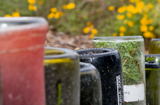Recycling in the Garden
Being green in the garden can go beyond plants. Home gardeners can find used or environmentally friendly landscaping materials can also create their own from some non-traditional sources. Using recycled materials is often cheaper than buying new materials, and it keeps waste out of landfills. Check the ideas below and lyou might discover a new use for some of your own unwanted items.
Concrete
Broken concrete is often leftover from construction and development. Build “stone” retainer walls by placing the broken side of the concrete on the outside. Over time, weather and watering will make the concrete look like real rock.
Edge flower beds or create walkways or patios. Fill in between the pieces with sand for a mosaic effect.
Carpet
Lay down carpet over an area for a new garden bed and let it sit for several weeks. Afterwards, the grass underneath will be decomposed, making for easy digging.
Use carpet for pathways and top with mulch or stone. Make sure you use woven carpet, not rubber-backed.
CDs
Scratched CDs can become coasters for potted plants, candles, or other objects that can stain your deck or patio furniture.
Discourage wildlife foraging by threading CDs with garden twine or fishing line and hanging them in your garden.
Turn CDs into reflective mobiles or wind chimes using wire, hooks, and fishing line.
Styrofoam Peanuts
Use them in the bottom of potted plants to help reduce the weight of big planters. First put in a dryer sheet then a layer of peanuts. Next add potting soil, then your plants.
Break up larger foam pieces for use in larger pots or as bases for raised garden beds.
Plastic Bottles and Containers
Cut the bottom of gallon jugs and place over seedlings and young plants to protect them from cold. (Make sure to take them off during the day to keep plants from overheating.)
Turn plastic bottles into funnels or scoops for garden amendments.
Make a bird feeder by making cutouts with cross dowels for perches on the side of the bottle (keep the lid on to keep seed dry).
Newspaper Bags
Once you’ve laid down the newspaper as a weed blocking mulch in the garden, use the bag as a plant hanger. Double or triple the bags and fill them with soil. Knot the bag closed and lay it flat. Cut "X"s in the sides to plant small plants or herbs. Keep it flat for a week until the root system is established, then put in a few small drainage holes and hang it up.
Rainwater
Collect rainwater to use in during dry periods for your garden, houseplants, or mixing with garden amendments. Set barrels or large drums under downspouts, or just out in the garden. If you do not have room for or access to large containers, use a small pail or any other container you have. Put a screen over the tops to ward off mosquitoes.
Miscellaneous
Put dryer sheets in the bottom of flower pots to keep soil from coming out of the drainage holes.
Cut up snagged stockings for ties for vines and tomatoes.
Cut discarded mini blinds into six to eight inch lengths for plant id tags.
Look around your home to see what other items you might be able to use in your garden. Don't forget that items can also be used for yard art: cans and old dishes as planters, utensils as markers and wind chimes, tree branches and trunks as sculptures, or bed sets as benches (use the headboard as the back and the footboard cut in half as arms). Recycling is a good way to bring out your creative side and build a uniquely beautiful garden area.
Adapted and excerpted from:
“Recycling in the Garden,” The Green Thumb Script Booklets, St. Lucie County Extension.
“Garden Trash to Treasures,” St. Lucie County Extension (accessed 05/2012).

Related Sites & Articles
- UF/IFAS Publications
- Sustainable Landscape Construction
- Recycle Yard Waste (1.12MB pdf)
- UF/IFAS Sites
- Creative Recycling in the Landscape

